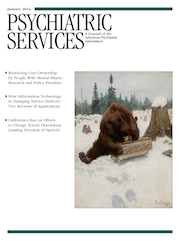State and Demographic Variation in Use of Depot Antipsychotics by Medicaid Beneficiaries With Schizophrenia
Abstract
Objective
This study examined state and demographic variation in use of depot antipsychotics among Medicaid beneficiaries with schizophrenia.
Method
Medicaid claims data (2007) from 21 states and the District of Columbia were analyzed for 102,884 beneficiaries age 18 to 64 with schizophrenia. Rates of receipt of depot antipsychotics were determined for all beneficiaries and for African Americans, Caucasians, and beneficiaries from “all other races.”
Results
Across study states, a mean of 10% of beneficiaries with schizophrenia received depot antipsychotics. Rates ranged from 1.9% in the District of Columbia to 20.9% in Alabama. In 12 states, African Americans were disproportionately likely to receive these medications compared with beneficiaries of other races.
Conclusions
Use of depot antipsychotics varied across state Medicaid programs. African Americans received a disproportionate share in many states. Further research is needed to understand the sources of such variation. These findings underscore the need to monitor the use of depot antipsychotics.



